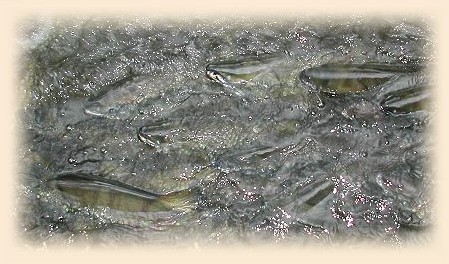|
Phil Frizell was a musician playing a gig in Sitka,
Alaska. One night a couple of local guys asked him
if he liked salmon. "You bet," he replied thinking
just maybe he was going to get a home-cooked meal.
Instead the guys said they would be happy to take him
along the next morning when they were going to get
salmon.
At o'dark thirty Phil showed up at the appointed place
on the dock with his tackle box and spinning rod.
The guys looked at him a little strangely, but said
nothing about his gear.
The sun came up and the outboard motor slowed to a stop
in an estuary. "Here we are," announced the first guy,
as he pickup up a badly stained wooden baseball bat.
Phil reached for his rod, and opened his tackle box.
The second guy handed Phil a baseball bat, as crummy
and stained as the first one. He said, "Hey Phil, we
didn't say fishing - we said 'going after salmon.'
You take the stern."
With that they all proceeded to 'take' their limit.
That was many years ago, but Phil swore it happened
just as he told it.
We have to work for our salmon here, and as far as I
know, hitting salmon on the head with a ball bat is
not a legal method. Fly fishing is.
The best of the Pacific salmon runs we have here on
Kitsap Peninsula is of the Chum Salmon. They are nick-named
'dog salmon' because of their huge teeth. They are terrific
fighters, and in my opinion, the most under-rated salmon
to catch on a fly. Like all Pacific salmon, the fish travel
enormous distances in the Pacific ocean before they return
to their natal stream, they make their spawning run and die.
Unlike Atlantic salmon or steelhead, once they spawn it is
all over. The two runs we are the most familiar with are
both 'natural' runs. That is, they were not ever stocked
in either place.

We are about two weeks from the closest run, it usually
starts about Halloween and sometimes lasts into December.
That depends on having some fall rains, and the runs may
be a bit early this year if the rains continue.

Various species of salmon eat different things, and at
different times in their development. On top of that,
salmon eat one thing while out at sea, and something
else as they are either cruising the beaches smelling
for their home river, and yet something else as they
are waiting in the estuaries. Some experts claim
salmon do not feed once they have entered freshwater.
The jury is still out on that. It may depend on how
long they have been waiting to make their run. In
other words, their biological clock is ticking. Hanging
out in an estuary for weeks waiting for rain to raise
water levels enough to make the spawning run may make
a difference in feeding patterns.
If you are interested in Pacific salmon or fishing for
them, a terrific book on them is: Fly Fishing for
Pacific Salmon by Bruce Ferguson, Les Johnson
and Pat Trotter, published by Frank Amato Publications.
Since we are so close to the ocean, the salmon we see
tend to be very bright and lively. The further the
salmon have to travel to their spawning grounds, the
darker they become.
We don't keep any of the salmon we catch - we have in
the past, but we gave away the smoker a couple of years
ago, and our friend Al keeps us supplied. If you are
planning on keeping any salmon to cook or smoke, a couple
of tips. Quickly release any female (hen) salmon. Their
flesh is soft (all their energy goes into making and
feeding eggs) and doesn't cook or smoke up well.
Besides, I'd rather insure another salmon run in three
years by not taking any of the hens. Kill any male you
keep by cutting the gills and letting them bleed out.
Do not let them soak in water, lay them on top of ice
in a cooler and cook (or smoke) as soon as possible.
In my opinion, they don't taste nearly as good if they
have been frozen. Eat them while they are very fresh.
I poached a small, bright chum one year in white wine
with chopped celery, carrot and onion and it was just dandy.

Recommended gear for Chum salmon here is an 8 weight rod,
floating line, and the fly of choice for us is
Castwell's Chum Fly,
barbless of course. (It's also the law here.) It goes
through the water column hook up and has less chance of
foul hooking a fish. Foul hooking a big salmon is fun for
a few minutes. We call it 'freight-train' - occasionally
you can land one, but once you decide a fish is foul-hooked
it is best to just break it off. Fighting one for a half
hour or more doesn't do the fish any good, especially if
you plan on releasing it.
I said, "big salmon" and Chum can get very big. The largest
I've caught was 27 pounds, it was fair hooked and spooled me.
Twice. The average size we catch here are closer to 15 pounds,
and they can give you a real battle.
We don't have our gear out yet, but it won't be long.
I'll write a bit more as we get closer to the run. If
you've always wanted to catch a salmon, this may be the
most angler friendly opportunity you could have. No boat,
no guide, just fishing in waders, casting in an estuary
for visible fish.
Bring it on, I'm ready! ~ DLB

If you would like to comment on this or any other article please feel free to
post your views on the FAOL Bulletin Board!
|





